Remembering Keith Haring
On February 16, 1990, renowned artist Keith Haring passed away. Decades later, his life and legacy still live on in two iconic murals in New York City parks.
You couldn't hang around NYC's 80s art scene without hearing Keith Haring's name being tossed around with the likes of Andy Warhol, Jean-Michel Basquiat, Grace Jones, and the performance art scene at Club 57.

Keith Haring poses near the Crack is Wack Mural in 1986. (Photo by Tseng Kwong Chi)
Haring's signature drawings of chalk-like outlines first spilled onto NYC's graffitied subway stations, and by the late 1980s his public art pieces became a monumental voice in tackling social issues evolving around the 80s crack epidemic, sexuality, love, and diversity.
Born in Reading, Pennsylvania on May 4 1958, Haring became interested in art at a young age, drawing cartoons with his father. But it wasn't until Haring enrolled in the School of Visual Arts and moved to NYC in 1978, that his career took off.
Fascinated by the bold graffiti that sprawled over almost every public area in the city, as well as Christo's Running Fence, and works by Jean Dubuffet, William Burroughs, Pierre Alechinsky, Brion Gysin, Andy Warhol, and Robert Henri, Haring navigated his way to creating impactful public art.
What started out as rhythmic, chalk drawings on black matte advertising panels on several subway platforms evolved into more than 50 pieces of public art, including two iconic murals that still stand today in New York City parks: The Crack is Wack Playground mural in Harlem and the Carmine Street Pool mural at Tony Dapolito Recreation Center.
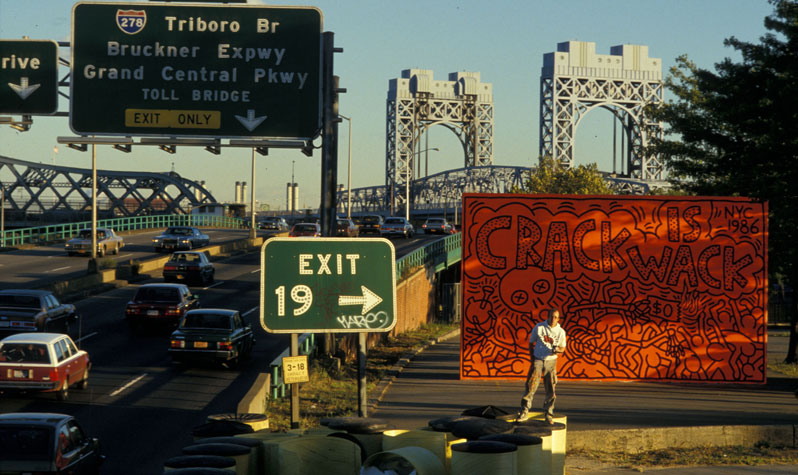
Keith Haring and the Crack is Wack Mural on 128th Streeet and Harlem River Drive. (Photo by Tseng Kwong Chi)
By the mid 1980s, crack, a highly potent and dangerous form of smokable cocaine, reached epidemic proportions. On October 3, 1986, Haring painted the famous Crack is Wack mural on a handball court in Harlem, sending a serious anti-drug message to the community which was riddled by drug abuse.
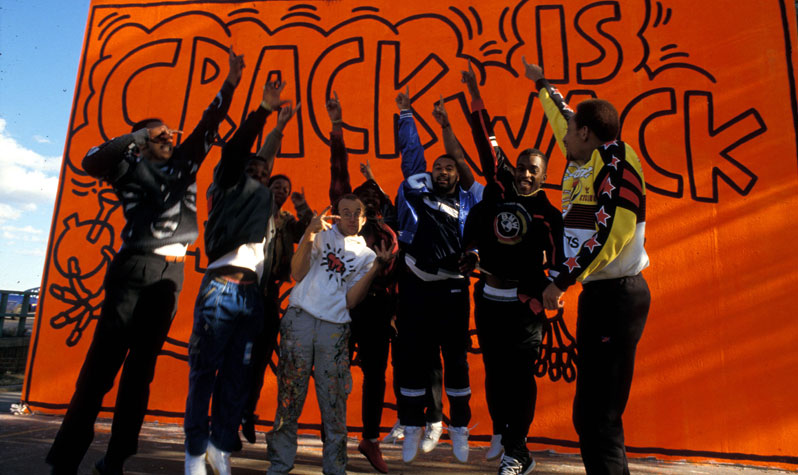
(Photo by Tseng Kwong Chi)
Done in Haring's signature style of thick black outlines, bright colors, and intermingling, cartoon-like bodies, the Crack is Wack Mural at East 128th Street and Harlem River Drive is a lasting reminder of Haring’s art, and continues through its wit and vibrancy to teach children today about the hazards of crack cocaine.
Over the years, the Keith Haring Foundation has financed repairs and restoration to the iconic mural. The mural underwent a major repainting in 2007 by Gotham Scenic, and was repainted and refurbished again in 2019 by Louise Hunnicutt and William Tibbals. Visit the Crack is Wack Playground and mural.
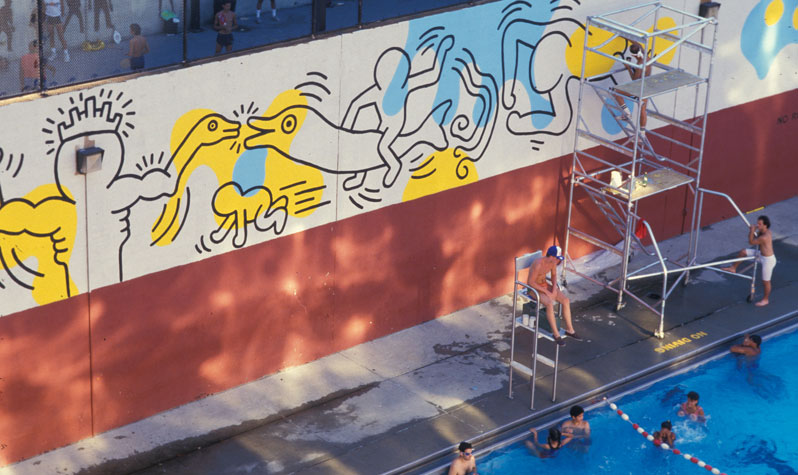
Keith Haring painting the Carmine Street Pool mural in the summer of 1987 (Photo by Tseng Kwong Chi)
In 1987, Haring painted a large mural at the Carmine Recreation Center’s outdoor pool in the West Village.
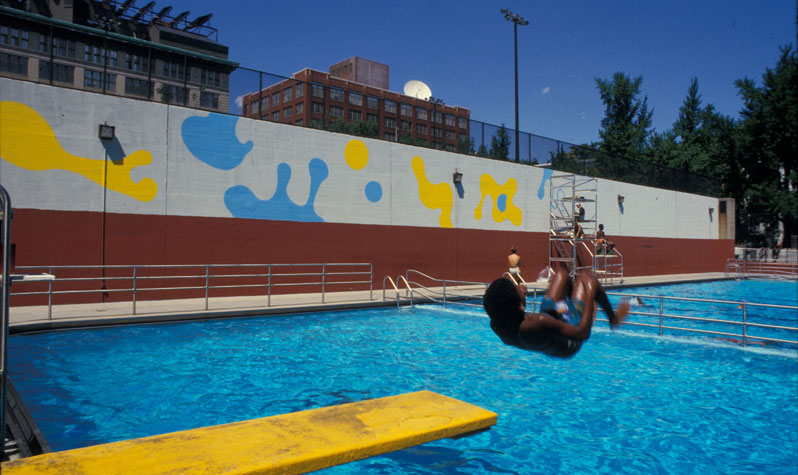
(Photo by Tseng Kwong Chi)
Measuring 18 feet high by 170 feet long and taking its cue from the hues of the pool’s underwater surfacing, the mural depicts bold stylized motifs of fish and children, as well as abstract shapes in black, white, yellow, and blue - images typical of Haring’s lively and colorful designs.
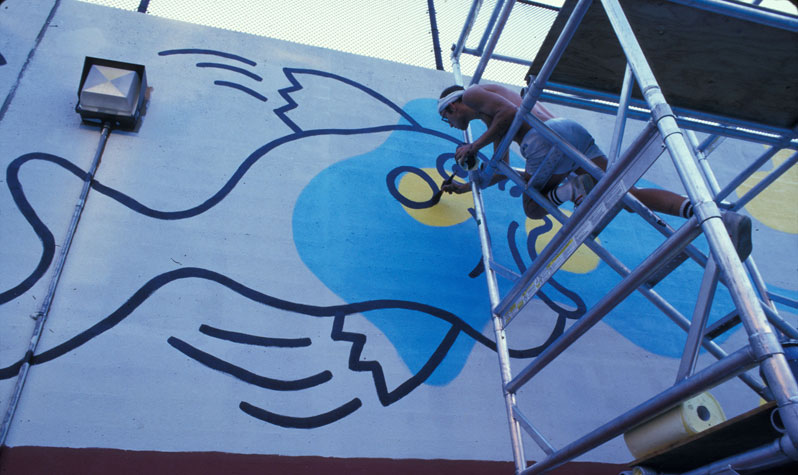
(Photo by Tseng Kwong Chi)
The Keith Haring Foundation has supported the preservation of the Carmine Street Mural on several occasions.
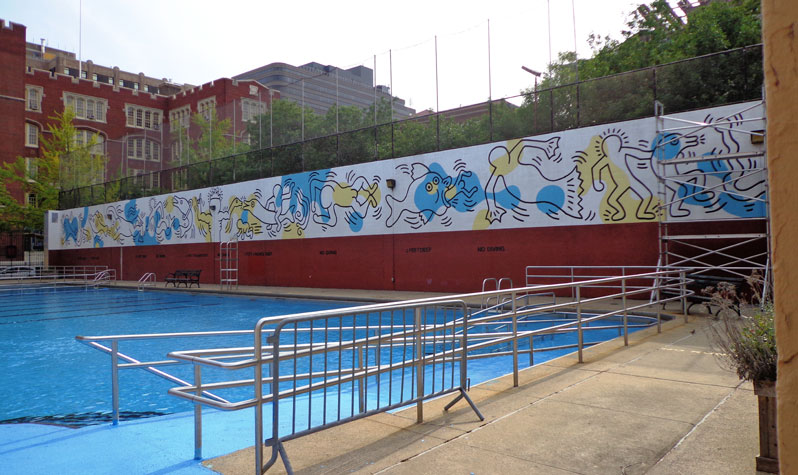
The Carmine Street Pool Mural after repairs and repainting in 2014 thanks to The Keith Haring Foundation. (Photo by Jonathan Kuhn, NYC Parks)
Tony Dapolito Recreation Center and Tony Dapolito Pool are currently under construction, and the Carmine Street Pool Mural is not on display. Visit our Capital Project Tracker page for Tony Dapolito Recreation Center for updates on this project.
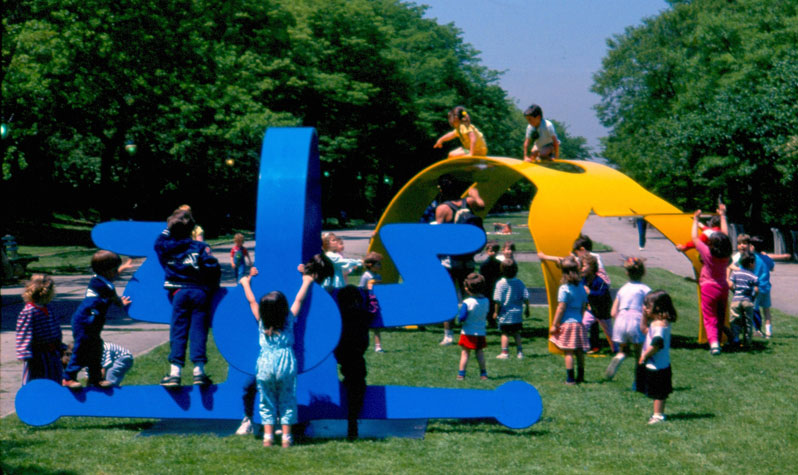
Keith Haring's sculptures were on display at Riverside Park from May 1988 to May 1989. (Photo by Tseng Kwong Chi)
In 1986, two of Haring’s sculptures were displayed temporarily at Dag Hammarskjold Plaza in Manhattan. The sculptures (shown above) were also displayed in Riverside Park from May 1988 to May 1989.
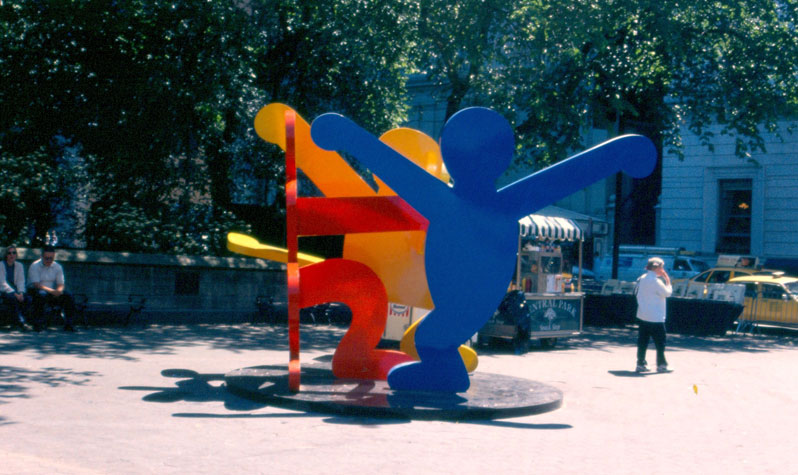
Keith Haring's Untitled (Three Dancing Figures) was on display at the Doris Freedman Plaza in 1997. (Photo courtesy of the Public Art Fund)
Haring went on to have numerous exhibitions of his work, and was represented by such well-known galleries as Tony Shafrazi and Leo Castelli. Haring art-directed music videos and produced coloring books and t-shirts for children. He opened his Pop Shop in 1986, while continuing to make logos for numerous charities, such as Learning through Art and Doing Art Together, just two of many programs he supported that brought art to schools. He provided funds for numerous children’s organizations, supported efforts to oppose apartheid, and created designs and donated funds to advance the cause of AIDS awareness.
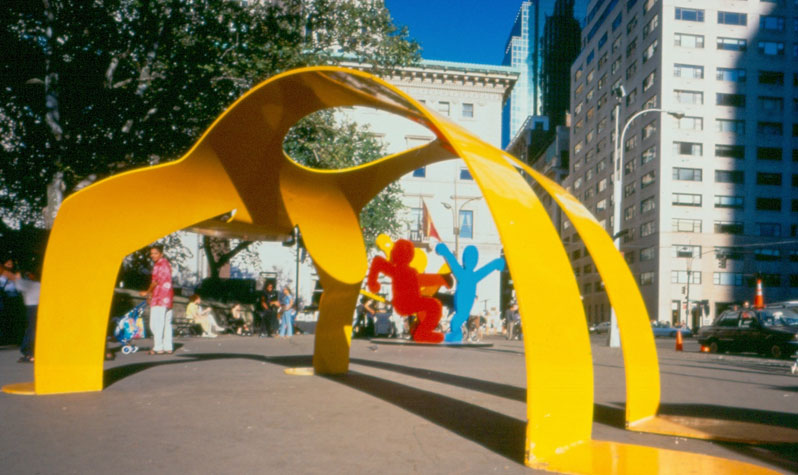
The Yellow Arching Figure and the Untitled (Three Dancing Figures) at the Doris Freedman Plaza in 1997. (Photo courtesy of the Public Art Fund)
Haring continued to create murals, sculptures, drawings, and paintings until he died of AIDS on February 16, 1990, at the age of 31. He left a legacy of art that was popular on a universal level, and had also garnered widespread critical acclaim.
A foundation in his memory was established, which continues to support the organizations he championed. In 1991-92, Haring’s Figure Balancing on Dog was displayed in Dante Park, and in 1997 the Public Art Fund, in collaboration with the Estate of Keith Haring, organized a multi-site installation of his outdoor sculptures at Central Park’s Doris Freedman Plaza and along the Park Avenue Malls. This public exhibition occurred simultaneously with a retrospective at the Whitney Museum of American Art.

Keith Haring's Self-Portrait sculpture on view at the Arsenal in 2007. (Photo by NYC Parks)
In 2007, Keith Haring's painted aluminum Self-Portrait, 1989 sculpture was displayed in the lobby of the Arsenal in Central Park, as part of the retrospective exhibition "The Outdoor Gallery: 40 Years of Public Art in New York City Parks." The sculpture is the fourth in a series of seven. The large-scale version was displayed on Park Avenue and 60th Street as part of a multi-site exhibition in 1997.
Thank you to the Keith Haring Foundation for preserving Keith Haring's NYC Parks legacy.
Related Video
Watch New Yorkers and The Keith Haring Foundation share their thoughts on Keith Haring's dance-like and artistic process in creating the Crack Is Wack mural and the Carmine Street Pool Mural.